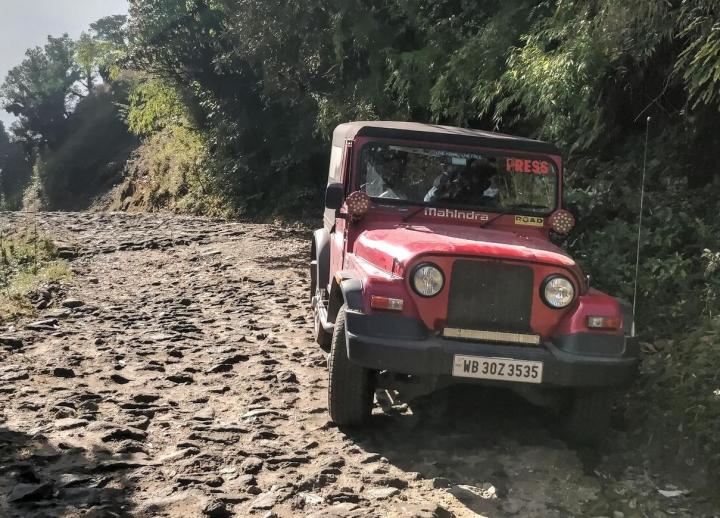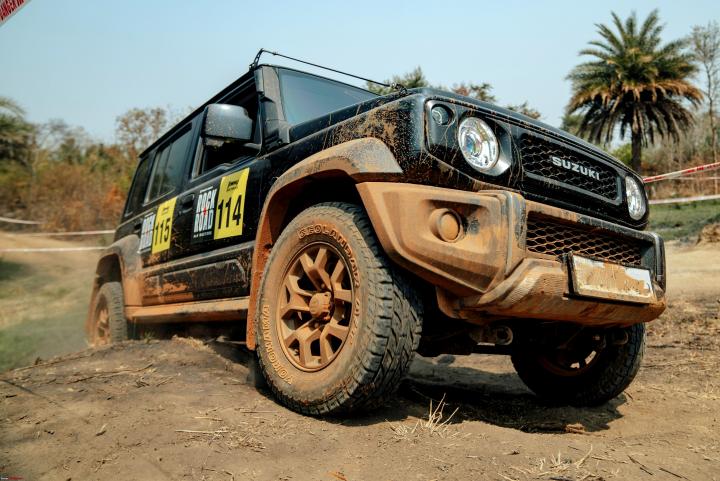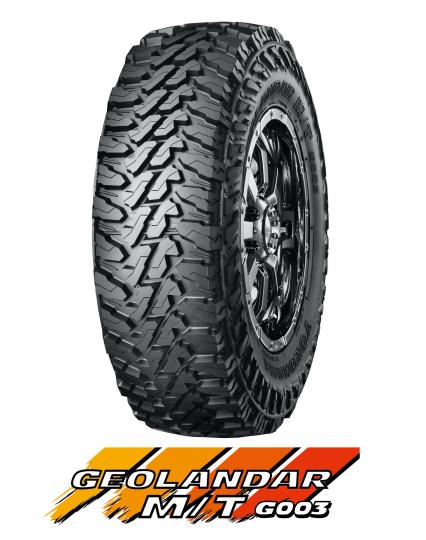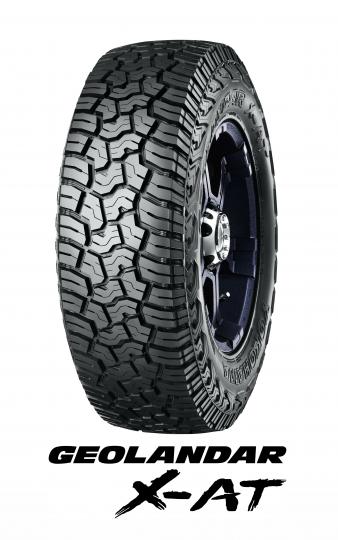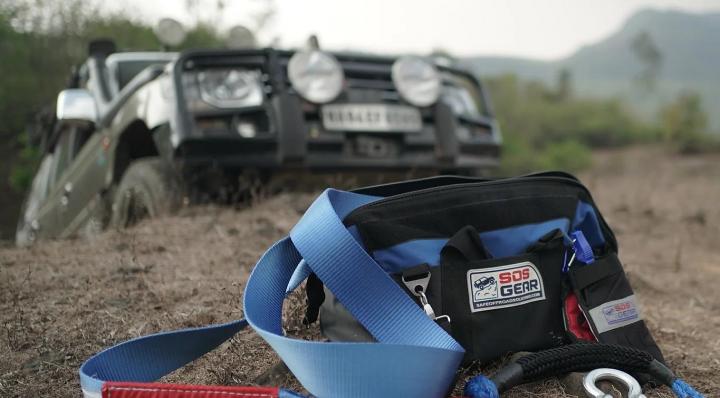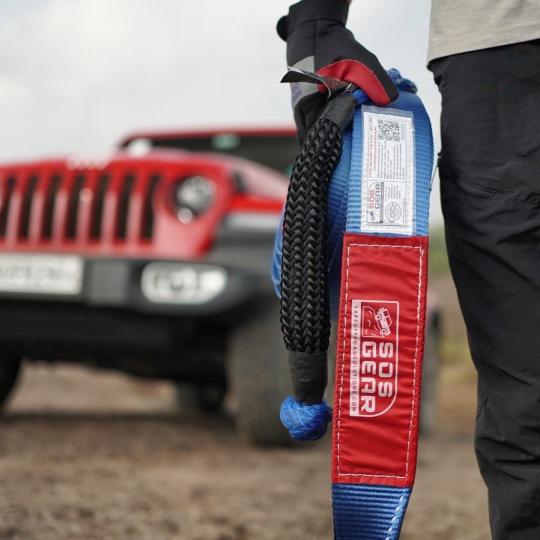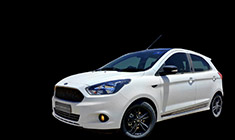News
Why I chose a Free Wheeling Hub for my Thar CRDe: Pros & Cons
The vehicle can be used with 2WD-L mode in specific and demanding situations.
BHPian Blooming Flower recently shared this with other enthusiasts.
Why I Chose FWH (Free Wheeling Hub) for My Thar CRDe.
Background:
I am not generally eager to modify stock setup in a vehicle unless a specific use case is defined for it. Recently, I have decided to move to FWH for my Thar CRDe.
First of all, I am not a hard-core off-roader; but I am an avid road-tripper, and most of my travel plans include at least one destination-OTR. Despite being a crude and not-so-road-worthy vehicle in today’s date my family and I are already acclimatized with Thar CRDe and its shortcomings for long-haul road trips with it. Thar CRDe, since its launch almost 15 years ago, has undergone many minor and major changes. I know a few early owners who got their Thar with auto-locking hubs (which costs a bomb for a pair), and also a few with fixed flange. There was no clarity as to why Mahindra switched to a fixed flange and again to an auto-locking hub a few months later. Maybe, cost-cutting and/or reliability and ease of use based on internal management decisions. However, mine came with an auto-locking hub from the factory, and to date, no major problems cropped up except a few minor and common niggles. Yes, they didn’t fail and are working properly as they should. Since the beginning, I could never perceive the click noise (as stated in the manual) even with the window glass down while the auto-locker gets engaged or disengaged. But it never caused a 4WD failure in my case while several failures were reported across the OTR community. In a few instances, even after reversing for 100 mtrs, (yes, you read it correctly, it’s hundred, not ten) the hub locks did not disengage properly and used to make kat-kat noise while taking sharp turns. But this is not at all the reason why I chose FWH.
Use case:
It’s not quite surprising that to provide easy accessibility to remote locations the road infrastructure in India is improving rapidly. This makes the daily life of the local people easier; at the same time, it poses some tacit difficulties to part-time 4WD vehicles.
In the past few trips, while attempting to reach my destination through some no-so-known, uncharted roads/ tracks I found, of late, the initial few kilometres are converted to either concrete or tarmac by the local panchayat or PWD. Undeniably it’s a boon. The tracks don’t get unmotorable during the rainy season. But concrete or tarmac doesn’t essentially minimize the inclination angle (gradient) of these tracks. Because of the very narrow and twisty nature of the roads, a driver has to stop to give space for an oncoming vehicle to pass or must reverse and start from a standstill to negotiate a sharp 3-point turn. However, a certain drawback exists in the CRDe powertrain compared to its DI sibling. If you look at the torque curve throughout the RPM range the CRDe engine suffers from inadequate low-end torque. Then comes the gearings in the picture to worsen the situation. For Thar CRDe, I always felt the gap between the 1st and 2nd gear is very large. While climbing up with momentum through a moderately inclined road the RPM drops from the turbo band in 2nd gear, and sometimes 1st gear also fails to pull up an inch forward if the inclination is steeper. This warrants the use of the reduction gears in part-time 4WD vehicles. A torqy diesel powerhouse as in Thar CRDe handles those gradients like child’s play in 4L 2nd. 4L 1st is hardly required. And here comes the real problem.
As the concrete/tarmac road surface provides full traction to all the wheels there is barely any chance for required wheel slippage while driving in 4WD modes. The frequent twists and turns make the situation unfavourable. The steering already feels heavy with 4WD engaged, and one can feel it gets heavier with more turns. No doubt, it can be understood how much stress the entire drivetrain is subject to almost causing an onset of transmission windup. This particular situation demands the 2WD-L mode to utilize the torque to climb up without causing excess pressure on the transmission. An FWH for part-time 4WD vehicles with a full floating axle can make this a reality.
A question may arise why did no manufacturer give this 2WD-L as an option? The single-word answer is FOS (factor of safety). While the transmission is in low-range 2WD mode, the rear axle only has to handle the entire torque the transmission system delivers. This can cause untoward axle-twist and other failures. Reckoning this safety aspect why I am inclined to have this mode? More explanation of this is in the latter part of this post.
To my knowledge, the costly 4x4 vehicles, even full-time 4WDs viz. old gen T-Fort with 3 differentials also provide 4L only with centre differential in locked condition. This too apparently defeats the purpose and cannot eliminate the chances of transmission wind-up while plying on steep tarmac/concrete road. As of date, I have come across only one vehicle (Land Rover) owned by Bhpian Blackpearl in the UK providing 4L with centre diff. open condition. (The heartbeat of BlackPearl | Land Rover Defender 90 Review) This essentially offers the driving mode that is desirable from 2WD-L in part-time 4WD vehicles.
Why 2WD-L can be used without compromising safety:
Consider a situation where a 4WD vehicle carrying not much load at the rear has come to a standstill while negotiating a steep, uphill road in 2WD mode. To move forward, the driver has to either rev up very high burning the clutch in order to supply enough torque to the rear wheels or he/she has to engage 4L for ease. Now, to eliminate the chances of transmission windup if he manages to drive in 2WD-L mode what will be the situation?
If you look at the rear axle, the net twisting force exerted on it in either case (2H and 2L) will be exactly equal for moving the vehicle up. Rather, in 2H there remains a high probability of frying up the clutch.
Also, while in 4L both the front and rear propeller shafts are forced to rotate at the same speed. But in 4L with FWH unlocked condition (effectively 2WD-L), the front axle has technically no load (except the weight of the moving propeller and drive shaft, which is negligible compared to the load on the wheel). I agree, only the rear axle will be the driving axle bearing all the twist force to roll the vehicle uphill. But an axle is designed to take much more load than what is exerted by 2 pax. and a few baggage only on-board. Imagine goods carriers like Bolero pick-ups doing their regular duty on these terrains, which often carry 2-3 times the rated load without severe damage to the axle. So, with minimal loading in a passenger 4WD vehicle, the net twist force exerted on the rear axle in 2L mode is much less than its designed failure mode. With hindsight, the stress given on the entire transmission system (including front and rear axles) if driven continuously in 4L mode on such roads will be more detrimental.
To summarize the use case, the following points helped me decide to opt for FWH.
- Reliability: My preference for reliability factor for wheel hub in descending order is-
Fixed flange > Freewheeling hub > Auto-locking hub > Electronic hub lock (e.g. FAD in new Thar) > Vacuum actuated hub (e.g. Jimny).
The last two incorporate lots of electronics in feedback loops rendering them intrinsically complicated and not so robust and reliable. On the contrary, the first 3 are completely mechanical. Auto-lockers work similarly to the paul and Ratchet mechanism. But the most reliable one, the fixed flange, and even the auto-locker can’t fulfill the intended purpose.
- Cost: Needless to say, a FWH pair costs 1/10th of the failure-prone auto-locker.
- Installation and Maintenance: Unlike replacing the fixed flange with the FWH, Thar CRDe with auto-lockers, are very easy to install. No disassembly of the hub-lock is required. These are just bolt-on with a thin layer of RTV gasket maker and a few drops of removable blue Loctite. Pretty much plug-and-play! Maintenance is also easier.
- Safety: If kept in unlocked mode, in case an uninitiated driver mistakenly engages 4WD while driving in the not-so-desirable condition the drivetrain won’t be subjected to any untoward stress.
- Ease of use: No need to reverse a few meters to disengage the auto locking hubs (which is often of no use to cater to the purpose). Many times there exists no scope to reverse too.
- 2WD-L: The vehicle can be used with 2WD-L mode in specific and demanding situations.
Cons:
Only one for my use case. I have to come out to lock the hubs manually to utilize 4WD modes, which can be messy if the surface is muddy and slippery.
If you have also faced similar situations during off-roading, please pitch in how you managed to overcome the problem.
Check out BHPian comments for more insights and information.
News
10 years with a heavily modified Mahindra MM550: The journey so far
Over the last ~10+ years, this Jeep has undergone countless part replacements (Atleast 10 axle swaps), Numerous Changes to its body structure, different tyre rim combinations, different steering and suspension set ups and what not.
BHPian dhanushs recently shared this with other enthusiasts.
So.. this... is about a Jeep I own for over a decade now. Over the last ~10+ years, this Jeep has undergone countless part replacements (eg: Atleast 10 axle swaps), Numerous Changes to its body structure, different tyre rim combinations, different steering and suspension set ups and what not. All this has imparted me with tremendous learnings and knowledge which I will cherish for the rest of my life. This Jeep is also probably one of the reasons my Career and Life has taken a U-Turn to from being a Villager to a Corporate Employee (Apart from my personal reasons)
I will not be getting too deep into how this build, but, I will try to share some pics of the entire lifetime of this Jeep.
This is probably few of the first pics after when I bought the Jeep. With the alloys and tyres it came with. I may have only added the canopy to it.



Further which I changed the steering to RCBT and Upgraded the tyres rims and rear axle, IIRC.


Further into the build, I put a proper door, windshield, some lights here and there, some changes to the suspension and some other functional modifications.



Then came a winch, Hi Lift Jack.. some more mechanical mods like the LSD, New Axle, Better steering, Suspension etc...


And a Full page feature in the Local News paper.
Then came MT tyres into the picture.. Some body lift.. Minor mechanical mods..

Continue reading BHPian dhanushs' ownership review of his Mahindra Jeep for more insights and information.
News
Took my Jimny to my life's 1st off-road competition & enjoyed it fully
In the modified class, the cars varied by a huge margin. Big MT tyres, remapping, free flow exhausts, off-road bumpers, lift kits, rock sliders, winches and whatnot.
BHPian hemanth.anand recently shared this with other enthusiasts.
I recently participated in the Rock N Road 4x4 masters event with my Jimny.

On 28th Jan, I saw a post on Instagram by Maruti Suzuki about an event called Rock N Road 4x4 Masters. It was a Jimny-only event where 40 people each from 8 different locations will compete for the title of 4x4 master.
I immediately messaged BHPian avinashsg and checked if he would also be interested in registering for the event. The first reply from his side was “Are we prepared?”.
We had never participated in a driving competition as such. We have driven around the country on some challenging roads and no roads but this would be something else. I read a bit more about the event and I replied “This is an event for both Stock and modified Jimnys which means it would be relatively easier than many such competitions. We may not win, but let’s go for the experience”
The next day he replied, “Done, let’s do it then”. So, on 1st February, I registered my vehicle and both of us for the event.
Later I saw the video of the Delhi event and I saw Vijaykumar from Swastikfabs in the video and I messaged him just to check how is the event. He said the stages are very simple. Although “very simple” was encouraging, I knew that a “Very simple” for him would still be challenging for us who’ve never participated in such events in the past.
On 6th Feb, the organizers sent us the rules and regulations of the event and we were informed that the reporting time of Day 1 would be 0730hrs. they informed us that the location would be revealed close to the event.
With each passing week, we used to see videos of the event from other locations on Instagram and it started to look tougher. We were like “Did we bite more than we can chew?”. But every time I reminded us of Jimny’s tagline Never Turn Back and we were like “Let’s do it for the experience”. But both of us had one aim, that we should not end up in the last position.
On 26th February, we received a second communication from the organizers in which they revealed the location. It was Dirty Drivez, an off-road training academy/track on the outskirts of Bengaluru. This was the same place which I had visited some months ago for another a Jimny test drive event. The place was rather small and simple with no scope for extension. I was wondering how they’ll organize this event.
When we registered, Avinash and I decided that we would visit some off-road tracks nearby and try to understand the car a bit more before participating. But for some or the other reason, we were occupied over the weekends. Only the weekend before the event, we could make time. We decided to drive to Achhalu Betta, an off-road hill climb to a temple 50 kms from Bengaluru. We also took along the Gypsy and another friend’s MT Jimny.
To our bad luck, the road to the top of Achhalu Betta had been recently repaired and made into a smooth mud road. Even a hatchback probably would climb to the top. Some snaps from the drive.

JiGyps at Achalu Betta base
Dashboard footage of Achalu Betta
On March 5th, all participants were added to a Whatsapp group for quick and easy coordination. The reporting time on Day 1 was 0730hrs. On March 8th, the day before the event, Avinash and I spoke and decided to leave home at 0600 to 0615 the next day.
Day 1, Saturday, 09th March 2024
I was looking forward to the event so much that I got up before the alarm and got ready. Avinash reached my home at the agreed time and we left home at 0615hrs.
We reached the venue at 0700hrs and we were among the first few to reach. After a small round of introduction, we were waiting for everyone to join.

The Event HQ

The line up of early birds

The monster Goat
The organizing team took some time to organize everything and the registrations started by 0830hrs.
At the registration desk, our documents were verified and we had to sign an indemnity form. We were handed over the vehicle stickers, food coupons and rules booklet. We were informed that the Scrutiny will begin soon after we paste the stickers on the car. The briefing for all the drivers was scheduled for 0930hrs.

Registration desk
We pasted the stickers and reduced the air pressure of the wheels and were ready for the scrutiny. The officials came and completed the scrutiny and we then waited for the driver briefing.

The scrutiny card, rules booklet and stickers

Pasting the stickers on the door

Vehicles lined up for scrutiny
The breakfast truck arrived and we were having our breakfast while Mr. Ashish Gupta from MSIL addressed the marshals. By the time the breakfast was over, the driver briefing started.
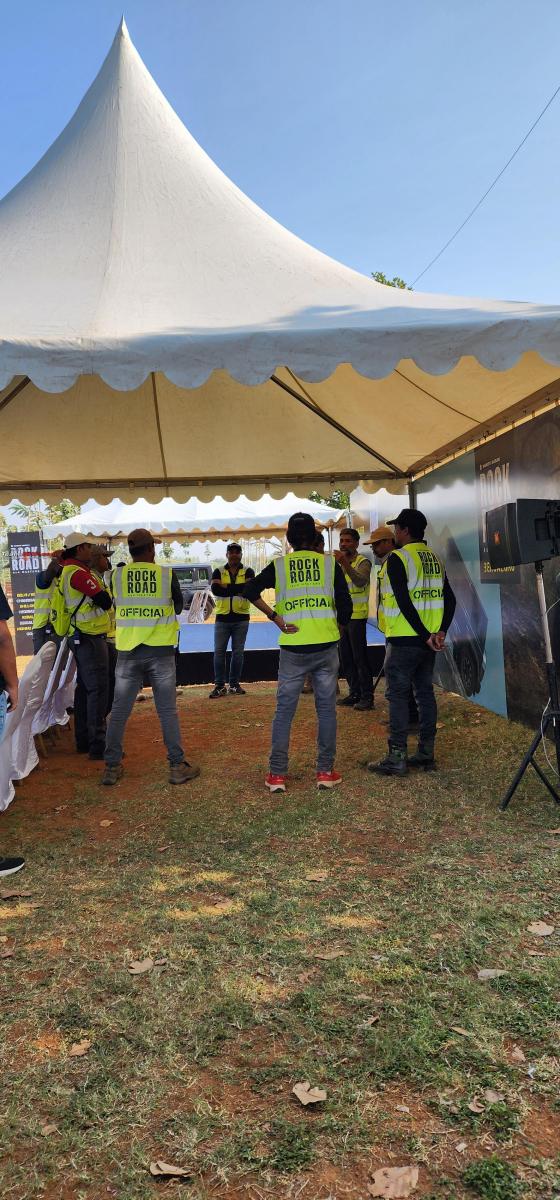
The Marshals being briefed

The stage
We were explained that the event will have a total of 8 Special Stages (SS1 to SS8) which would test not just the vehicle, but the driver skill and ability to complete the courses. We had to complete 4 SS each day. While one SS was within the training academy called Event HQ, three others were designed in a field close by. The 40 participants were split into groups of 10 and each one would start with an SS and after completion move to the next SS. We were in the second group (cars between 111 to 120).
Each SS had a different set of challenges and rules. For example, going around a track in a defined way (marked by pegs and buntings), making a loop a certain way for a predefined number of times, driving onward in a certain path and returning in a different path, etc. There were penalties for breaking the bunting, breaking the pegs, not wearing proper gear (helmets, closed shoes and seatbelts were mandatory).
Only the first group for that track would be given a walk-through and later drivers were supposed to see other cars and understand the track. Failing to start would be awarded a DNS (Did Not Start) which means 0 points. Any driver failing to complete a course as per the rules will be awarded a DNF (Did Not Finish) with 20 points. The fastest driver to complete the course combined with the lowest penalties for a particular SS would be given 100 points and others would be given points in accordance to that. Totally a driver could score a maximum of 800 points and a minimum of 0 points. The timer button was beside the starting box and the driver was responsible to start the timer, sit in the car, wear all safety equipment and start the course, complete the course and come back and stop the timer. All the SSs had a max time of 10 mins beyond which a driver would be awarded a DNF.
All the SSs were the same for Stock as well as modified classes of vehicles. This was probably MSIL’s way of showcasing the capability of the vehicle.
215/75R15 tyres that I had are still considered as stock. But because of the throttle controller and the snorkel, mine is classified as Modified. In the modified class, the cars varied by a huge margin. Huge MT tyres, remapping, free flow exhausts, off-road bumpers, lift kits, rock sliders, winches and whatnot.
At the end of 2 days, only two winners would be picked – one in the modified class and the other in the stock class. Who would then advance to the finals in Goa on March 23rd.
With that done, All 40 cars were flagged off. Since we were in the second group, we started with the SS2 first. The track marshal gave a walkthrough to the group.

The SS official giving instructions
A brief description of SS2:
- Right after the start box, get a small and steep incline.
- 100 mtrs later take a sharp left U-turn (with the right wheel a mtr below the left wheel)
- 100 mtrs further was a tree where we had to take a right turn
- Drive across a small yet deep sewage ditch.
- 10mtrs later Drive across another ditch.
- Take a sharp to climb up an incline
- Make an anticlockwise loop around bushes
- Come back to cross the two ditches and return on the same path
Car #111 was a stock white MT. He started well and completed the course in around three and a half minutes. Although he completed the course, he lost the skid plate to the Ditch#1.
Car #112 was heavily modified (235/75R15 MT tyres, Stage2 tuned, big snorkel, off-road bumpers and all). His car got stuck in Ditch#1 and had to be recovered. While trying to navigate, the tyres dug up further to make it slightly more deeper and more difficult for the next cars. This was the first recovery of the event and we got to see the recovery vehicle do its thing. it’s a monster and not how a Jimny should look like, but then, it is a recovery vehicle after all.

The Monster Goat

Recovery in progress
Car #113 was a stock one and he ended up getting stuck in the same ditch and had to be recovered.
Then it was my turn. I had planned to take the ditch at an angle.

Starting SS2
I started the timer, got into the car, started well, I got down the first incline, took the U-turn and soon I was in the ditch. It was a narrow right-hander path with bushes all around. I had planned to take the ditch at an angle, which meant I had to go straight at the right hander. But when I actually came to the ditch, with the narrow path, I got more focused on not breaking the peg and bunting on the left and I turned right and thud! I got stuck in the ditch with my number plate bang on the other side of the ditch. There was grass on the ground and all 4 wheels lost traction. Trying to steer and accelerate only worsened and the marshals warned me of excess wheelspin. I had to be eventually recovered out as well. The number plate was bent which was just straightened by hand.
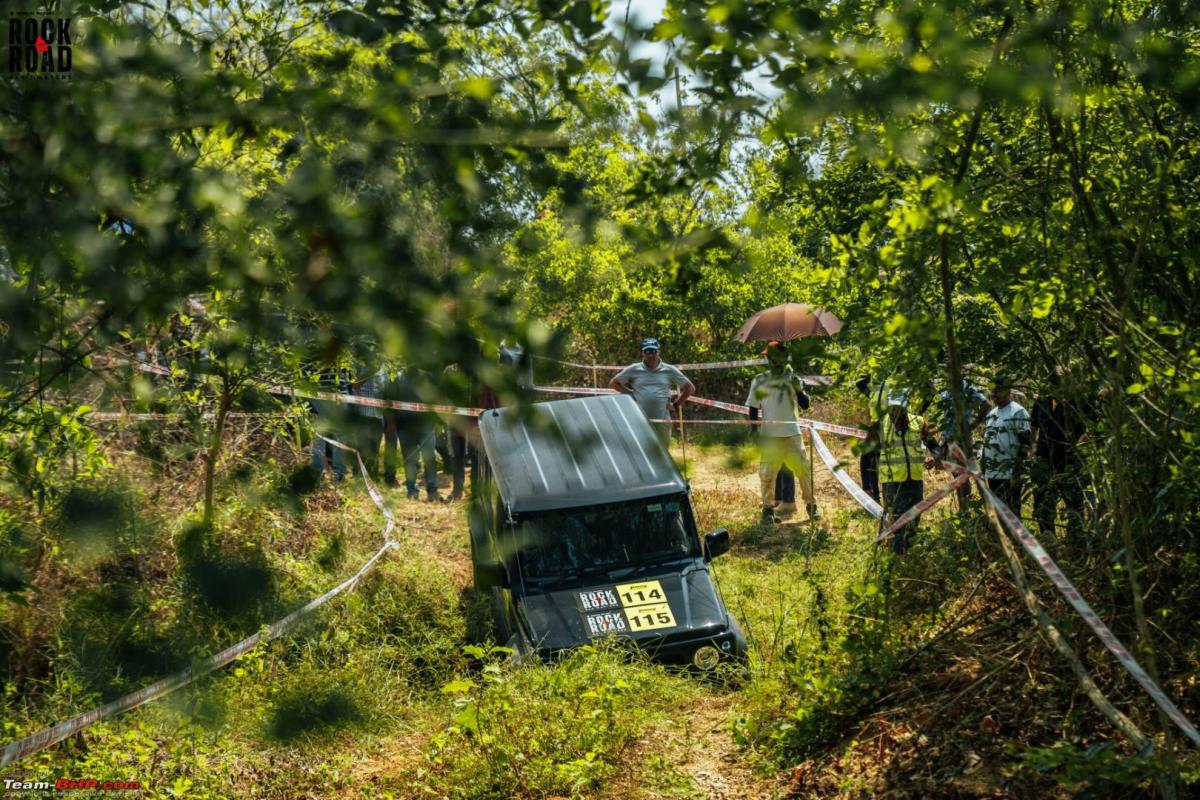
Stuck!
After the recovery, my car started again as number 115 with Avinash at the wheel. Same story repeated! With 4 drivers recovered one after the other, the word soon spread out and a lot of people started gathering at the spot.
#116 was a stock red car and the driver came and asked me how it was and I told him to take it at an angle. He did exactly that and cleared the ditch. Everyone started clapping and applauding. He crossed it on return too and completed the track. He lost his number plate though. He came and thanked me for the advice.
I learnt that giving advice is easy but doing it is difficult. Later I realized that the whole event was designed around this. You may have the best vehicle, you may have the best mods, you might be skilled too. But it comes to how you perform at that time. Over the day, the ditch took a toll of 10/37 (3 DNS) cars and all 10 had to be recovered. I think these 10 were the only recoveries of the entire two days.
SS3 was right next to SS2.
A brief description of SS3
- Get down a small incline
- 100mtrs later take a left-U turn around a pine tree
- Drive up a long incline with a right hander
- Take a right and cross an opening in between two pegs making sure all 4 wheels cross those pegs
- Reverse into another opening making sure that the rear wheels cross the pegs.
- Get down into a clockwise loop around some pine trees once and you’ll end up at the top
- From there come back down on the same path as the onward.
While Avinash and I passed this without any penalties, some really fast drivers got a DNF because of small errors like missing to follow the defined course or the wheels not crossing the marking pegs etc.
We then moved to SS4. A description
- Get out of the start box and drive into a small canal-like area
- Drive through the sandy/stony path and exit via a steep right-hander.
- Get down and circle around a tree anti-clockwise to come up again. Repeat this loop twice
- Get down into the same canal-like area with a left
- Drive through the canal and exit further ahead (not the same that we got in) and finish.
The exit was much steeper than the entry and tests the breakover angle of the vehicle. This was the challenging part of this track. Apart from this, the loop in this was just beside the ditch#1 of SS2. With recoveries in SS2, this track also had to wait for some time for clearance.
In the previous group which did this, one vehicle got beached! When we came to the start point, One Jimny took the exit a little too fast and broke his bumper.
Both Avinash and I passed this without much fuss. Avinash was a little too careful because it was my car (although I told him multiple times not to worry) which was quite understandable. Due to this, he couldn’t exit the steep incline on the first attempt. He had to reverse a little and then crossed it at the second attempt.
We later on moved to the HQ for SS1. The previous batch was still doing this track and hence we went to have lunch in the same food truck. In the entire event, food on day 1 was probably the bad part. The options were not enough, too expensive for what it offered, it was all too dry and tasted bad, drinking water was also not available and each litre of water bottle was priced at ₹50/- (one food coupon). I generally don’t waste food but I had to give away half of what I ordered to some stray dogs in the area. I just bought some juices and then we also finished some snacks that we had already bought ourselves. The unusually Hot weather this year in Bengaluru made it even worse. All of us gave this feedback to the organizers.
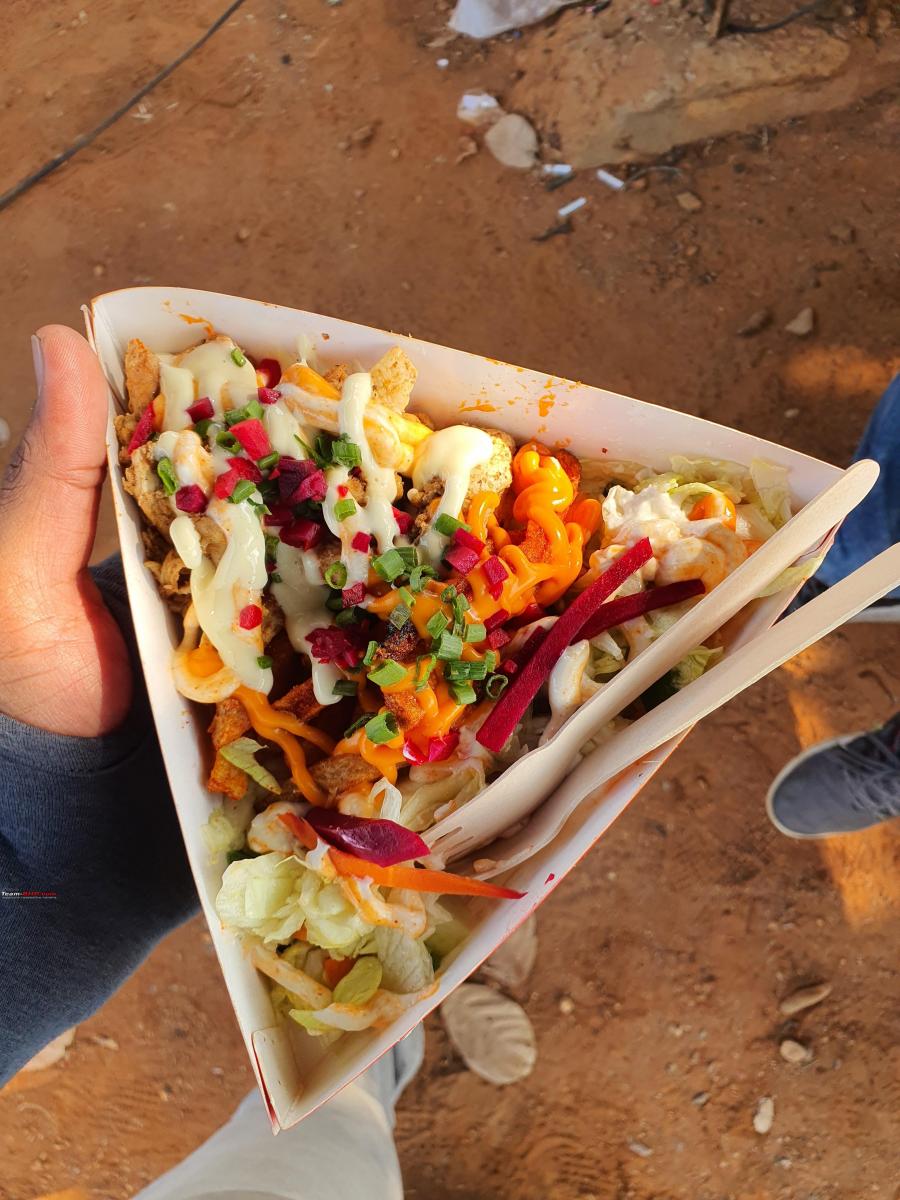
Breakfast and lunch
After whatever we could eat, we reported at the SS1 start point.
The SS1 was:
- From the start box, Drive on the ground level that gradually slopes upwards (one level up).
- Take a sharp Right U and get into a steep and deep gorge that is one level below the ground level (two levels down).
- Navigate the wavy gorge and at the end of it exit into the ground level with a left U almost the start point (one level up)
- Drive back in the same gradual slope and then this time make a Left U turn (one level up)
- Get into a patch filled with slush and drive through it to come close to the start point again (one level down)
- Cross over into the deep gorge and drive through it in reverse (one level down)
- Exit the gorge with a steep climb and take a Left-U (two levels up)
- Descend down into the start box (one level down)
The tricky part in this was only remembering the track. The vehicle can easily tackle the other things. A shorter turning radius would’ve helped in faster track timings. Both of us finished this easily without any penalties.
With all the SS of the day done, we both decided to return home. We left at 1500hrs and reached home. We both had only one regret…the regret of not completing the SS2!
Later in the day, the standings were shared and I was at #34 and Avinash was at #31. There was one car which didn’t start on any track.
Later in the night, the organizers sent a note that they’ve got a new vendor for food and the prices were revised. They apologized and told that they will take care of the food for the next day. We really appreciated the quick action.
I had kept an alarm for 0600hrs and slept off.
Continue reading hemanth.anand's off-road experience for BHPian comments, insights and more information.
News
Yokohama launches next-gen Geolandar Xtreme all-terrain tyres
The Geolandar X-AT and Geolandar M/T G003 come with an M+S rating (Mud and Snow) and a Rim Protector.
Yokohama has announced the launch of two new all-terrain tyres – the Geolandar X-AT and Geolandar M/T G003, in India.
The Geolandar X-AT is positioned between ‘All Terrain’ and ‘Mud Terrain’, and is said to offer superior traction and stability on both paved roads and off-road trails.
The Geolandar M/T G003 has been designed for loose terrain (mud and slush), offering better traction and control in off-road conditions. The tread pattern has been designed to enable drivers to take on muddy trails, steep inclines and rough terrain.
According to Yokohama, both tyres offer enhanced wear and side-cut resistance. This has been achieved with a new compound and sidewall design, improving the lifespan and reducing the risk of punctures or damage.
The Geolandar X-AT and Geolandar M/T G003 meet the general specifications required for off-road use. All sizes come with an M+S rating (Mud and Snow) and a Rim Protector for added protection against curb damage and abrasions.
News
25 Thars from Bangalore go on an off-road expedition to Nagaland
While 11 owners decided to transport their Mahindra SUVs through trucks, the rest of them formed small groups and decided to start earlier and explore the North East.
BHPian karthikd21 recently shared this with other enthusiasts.
"I have found a new passion to work the whole year to earn a well-deserved reward in the form of a yearly group expedition!" This has been the mantra of our group Thar-Bengaluru since the time we started the "Yearly Expedition" concept 2 years ago.
Last year, it was an expedition to Spiti (36 Thars and a Winter Wonderland) thread by @turbonath. While Spiti was the inaugural expedition in search of Snow, this year we wanted to up the ante to make the best use of what Thar is designed for! So, it was Nagaland.
Disclaimer: Permissions for all the trails inside forest and waterbodies were duly obtained from the local authorities by the expedition organizers
A teaser of what to expect




Prelude
Expedition bug once caught cannot be overcome, ever! After an amazing Spiti drive, every one of us was eagerly looking forward to the announcement of the upcoming adventure. In the last 2 years, our love towards off-roading had increased multifold and so had our level of confidence in our Thars' performance. Given this, it was obvious that as an adventure-focused group, we wanted off-roading as the main criteria surrounding the expedition. Although there were a few options like Arunachal Pradesh, Sikkim and Nagaland, it was decided that the expedition would be to explore the unexplored Nagaland as it meets our core need.
Planning
With 25 Thars and 45 people signed up, planning itself becomes a daunting task! Since the plan was to explore deep inside, there were a lot of initial apprehensions around the accommodation, food and most importantly safety. Off-roading is very much supported by the local authorities in Nagaland and we zeroed in on an organizer called 4x4 Attitude. This turned out to be one of the best decisions we had undertaken (more on that later). While 11 of the Thar owners decided to transport the Thars through Trucks to Guwahati, the rest of them formed small groups and decided to start earlier and explore the North East in a greater length.
High level plan
- Dec 25th: Reach Guwahati and unload Thars
- Dec 26th: Journey to Dimapur where the expedition would actually begin the next day
- Dec 27th: Dimapur to Wokha through off-beaten path
- Dec 28th: Trail day around Wokha, coffee tasting at Lithanro Coffee estate and reach Mokokchung
- Dec 29th: Reach Longwa, Indo Myanmar border
- Dec 30th: Endurance drive to reach Zunheboto
- Dec 31st: River trail and reach Touphema, New Year Party
- Jan 1st: Conquer Kopamadzhu Peak, camp
- Jan 2nd: Visit Kohima War Memorial, Green Village Khonoma and reach Benreu Tourist Village
- Jan 3rd: Trail around Peren and camp
- Jan 4th: Reach back to Guwahati, local shopping and stay the night
- Jan 5th: Load Thars to truck and fly back to Bengaluru
With us going to be exploring deep inside Nagaland, the organizers had their homework cut out to recce every weekend to mark the route and book accommodations. Thanks to WhatsApp, a big group was able to socialize and get to know each other through hilarious chat sessions, Q&A sessions (thanks to our beloved BHPian @airguitar), announcements by the expedition leads which kept us all on the toes in anticipation of the D-Day.
My wife needs a reason to shop! Last year in anticipation of the nail-biting cold, This year was snack and camping-related. She shopped ferociously and also prepared a lot of homemade ready-to-eat mixes as we had to feed our 10 and 13-year-old kids. Upma mix, Poha Mix, Puliyogre you name it, she had it!
Home Made


Store Bought
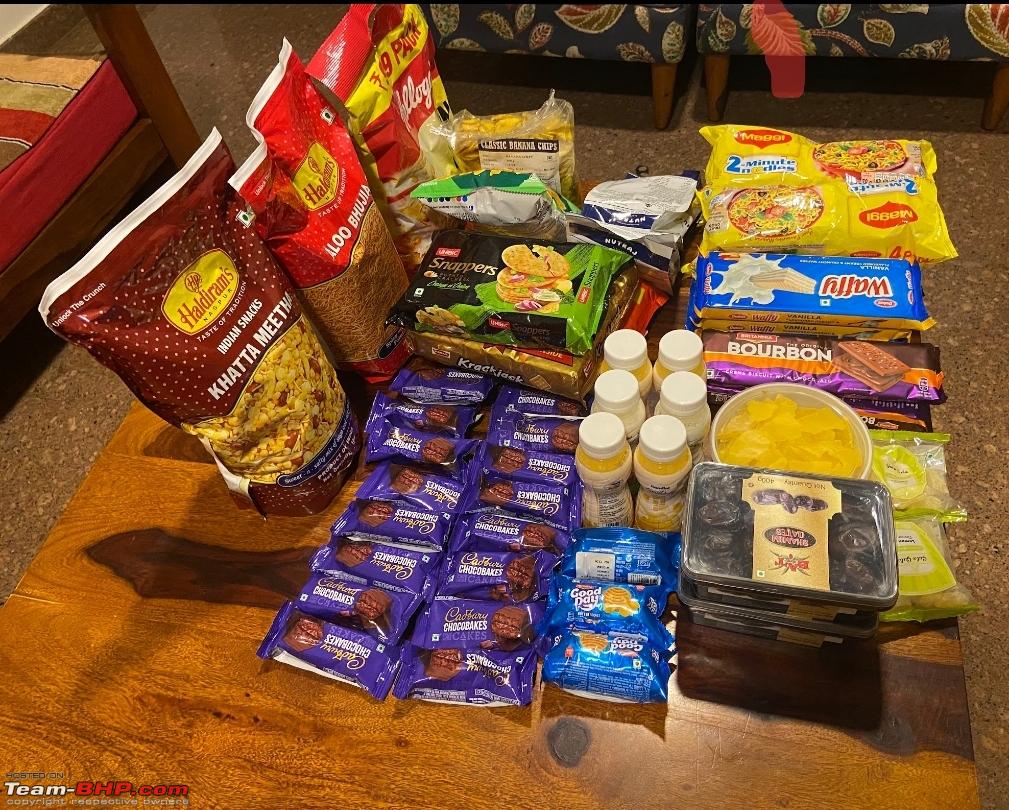
While some got busy shopping for food, proud owners of Thars preferred making them ready for the expedition!
Aux/Bumper lights/Mounts in anticipation of fog
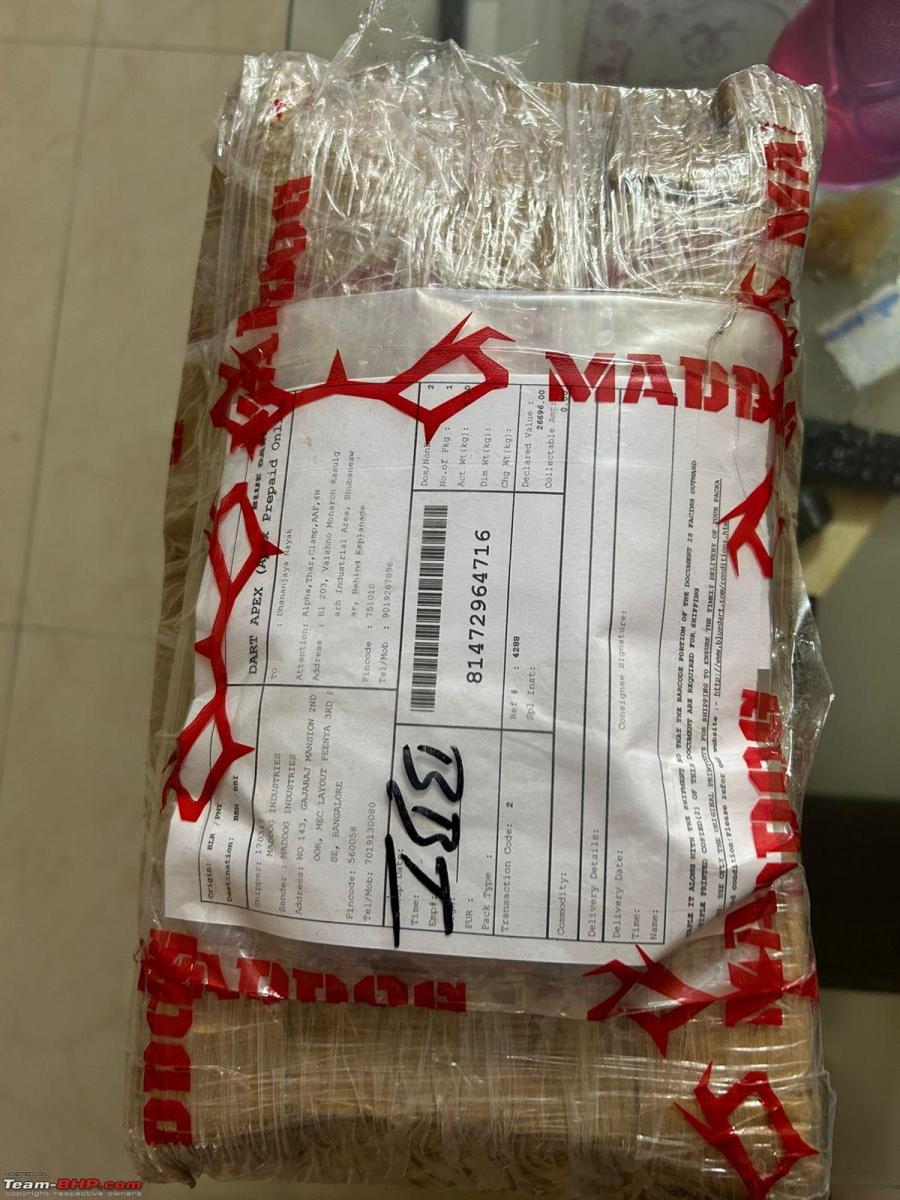
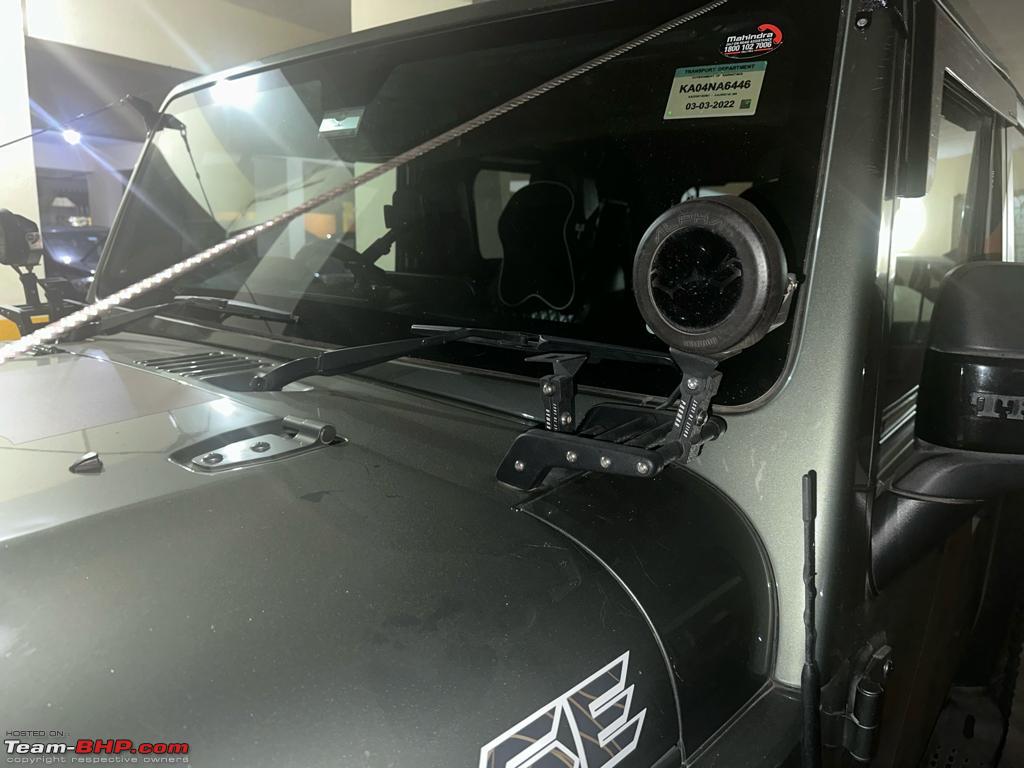



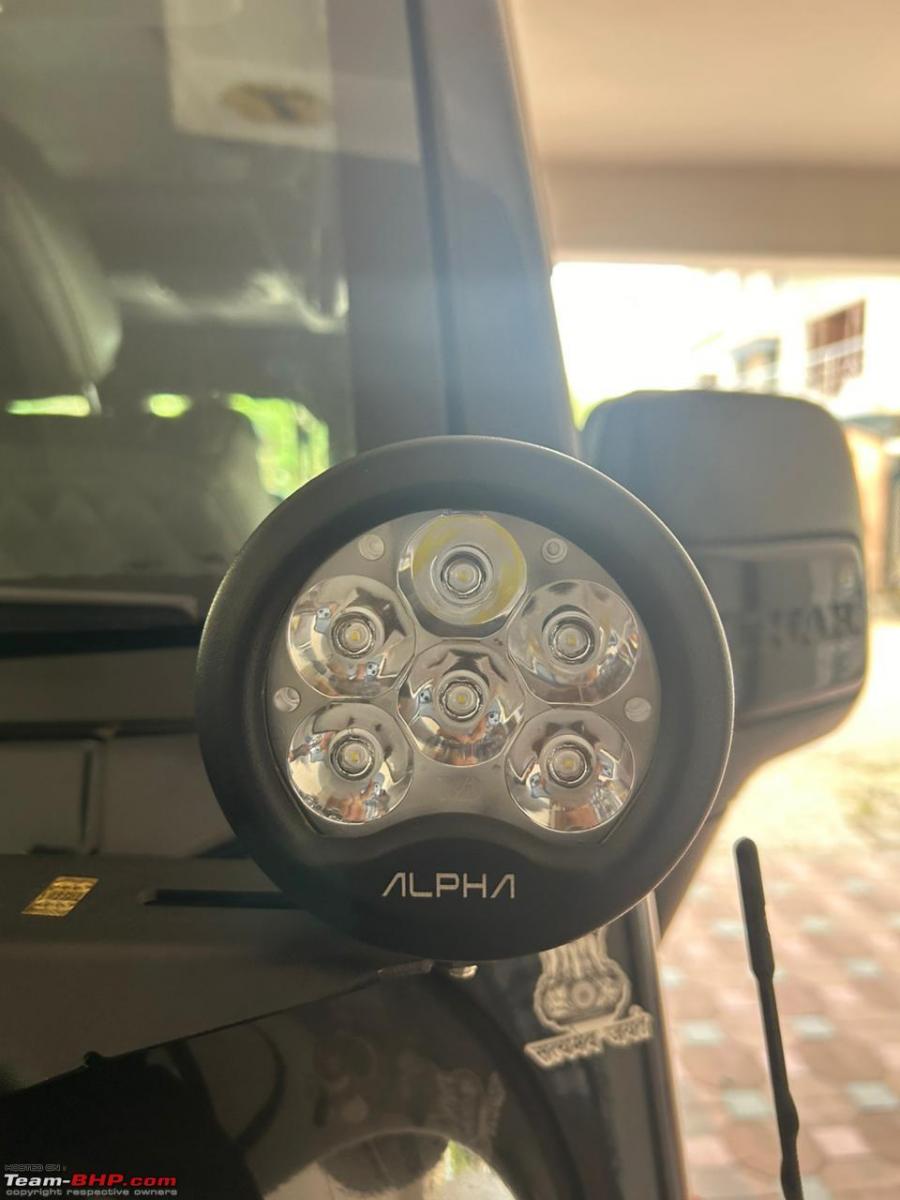
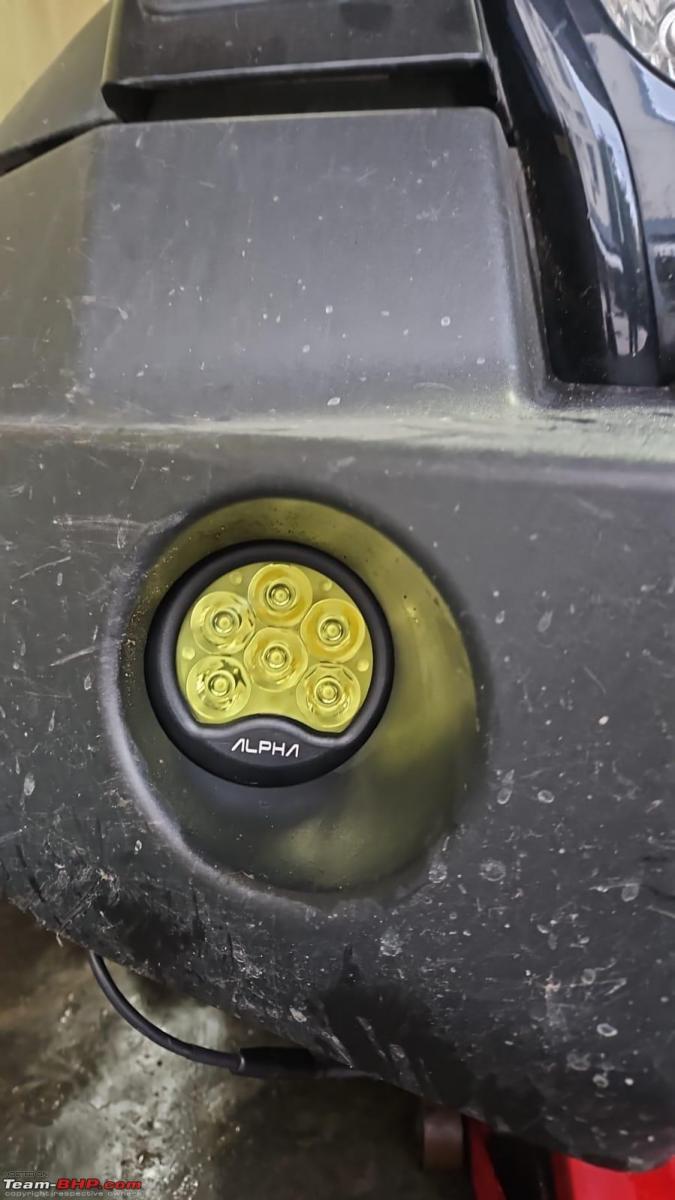
Jerry Cans

Thanks to @robimahanta for helping me with his Jerry can (not in the pic)
I got my differential breathers extended to under the bonnet in anticipation of water crossing


This is how a happy shopper looks like, Suchitra Bhide upon getting delivery of his Mad-dog aux fog lights

First Flag-Off
11-Dec: Thanks to Madhus Tyre Center for supporting us by hosting us for a flag-off. Had a great chat with Nikhil over coffee and cookies! We had to load our Thars to trucks the next day!
My Thar getting ready for flag-off
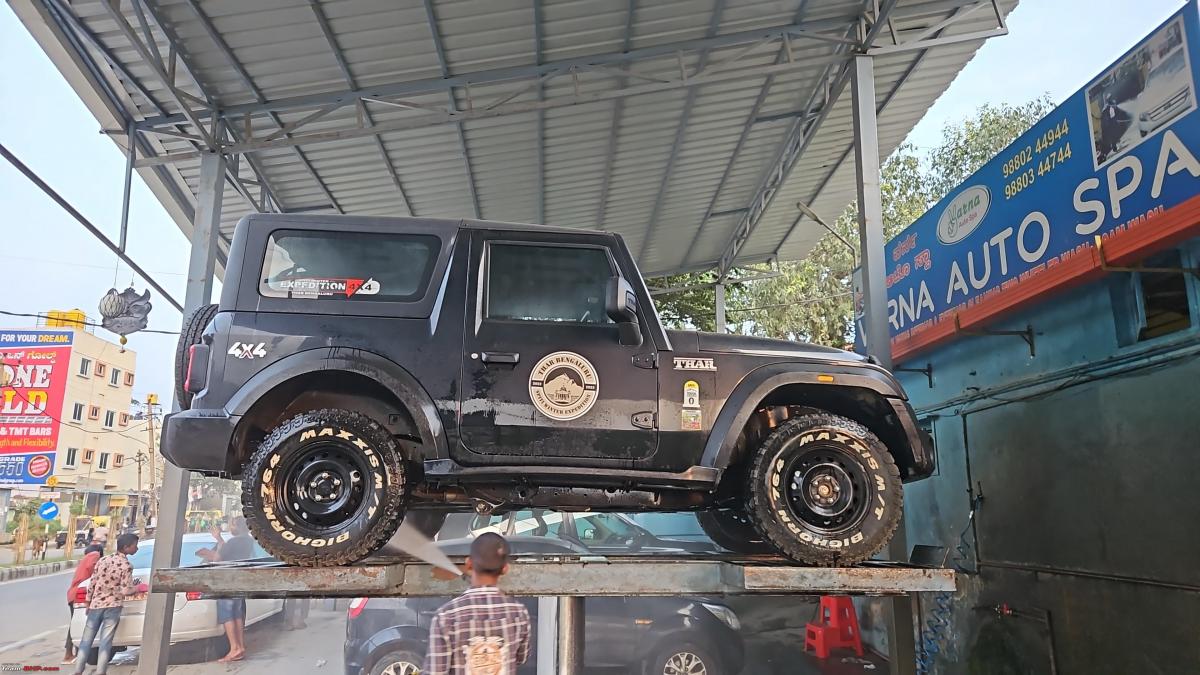
At Madhus
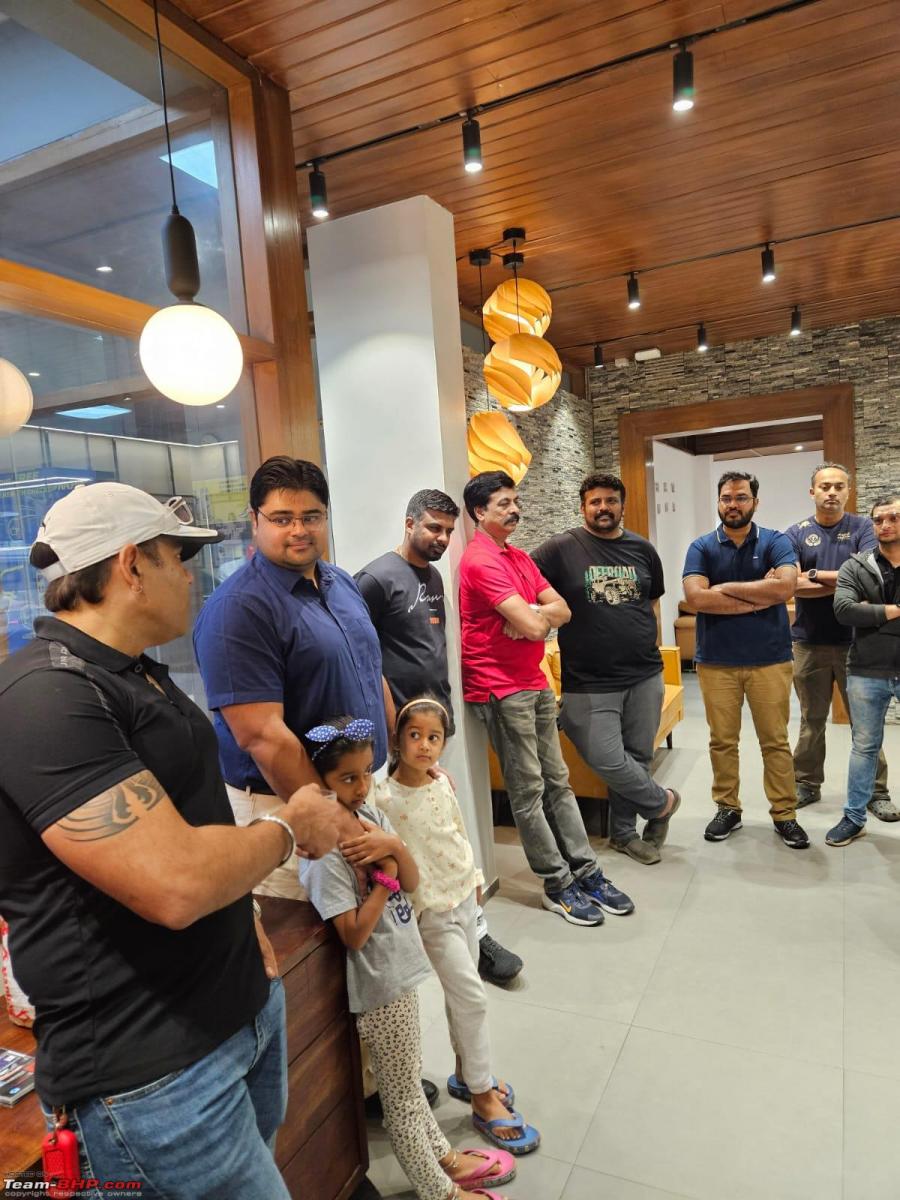
With Nikhil

Flag-Off
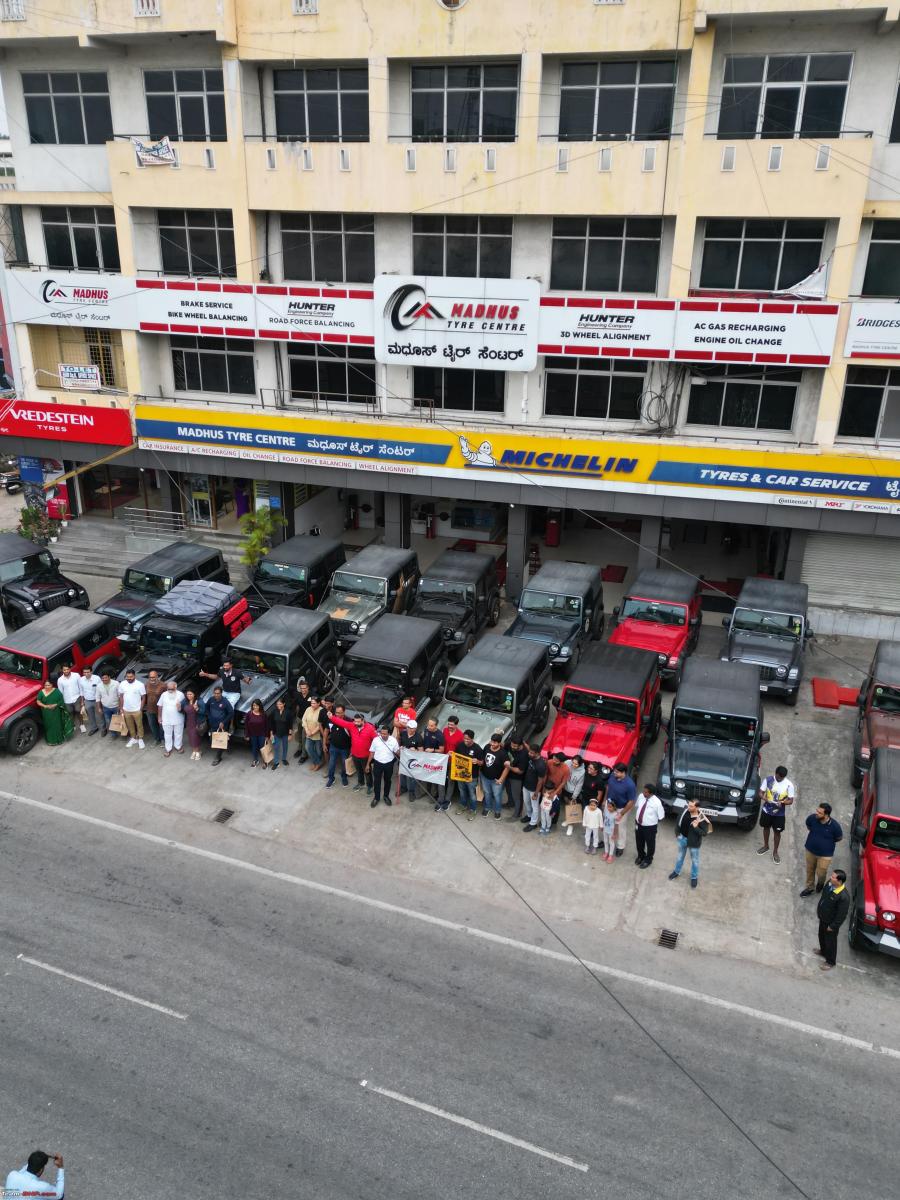
What followed the flag-off was our tradition of photo-op/flag-off at the Iconic Vidhanasoudha, a sumptuous breakfast at the Jayamahal Palace Hotel and a briefing by the expedition leads.
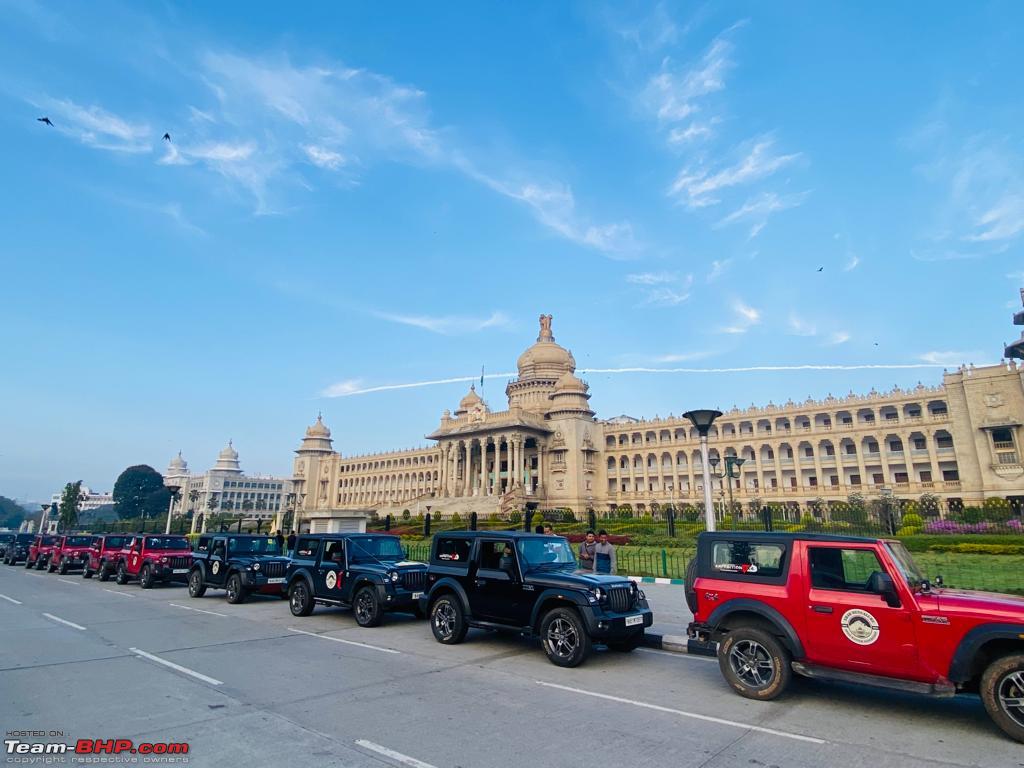

12 Dec
Finally sent off our Thars to Guwahati with repentance over not having the time at hand to drive all the way. 2 trucks were parked at Nice road exit near PES college and 11 Thars were loaded.

As our wait began for Dec 25th which is when we would fly into Guwahati, a few other groups started their adventure early and hit Arunachal Pradesh. Some random clicks from their trip
Snow at Arunachal

Gang at Bumla Pass

BHPian @airguitar's thar at Sela Pass
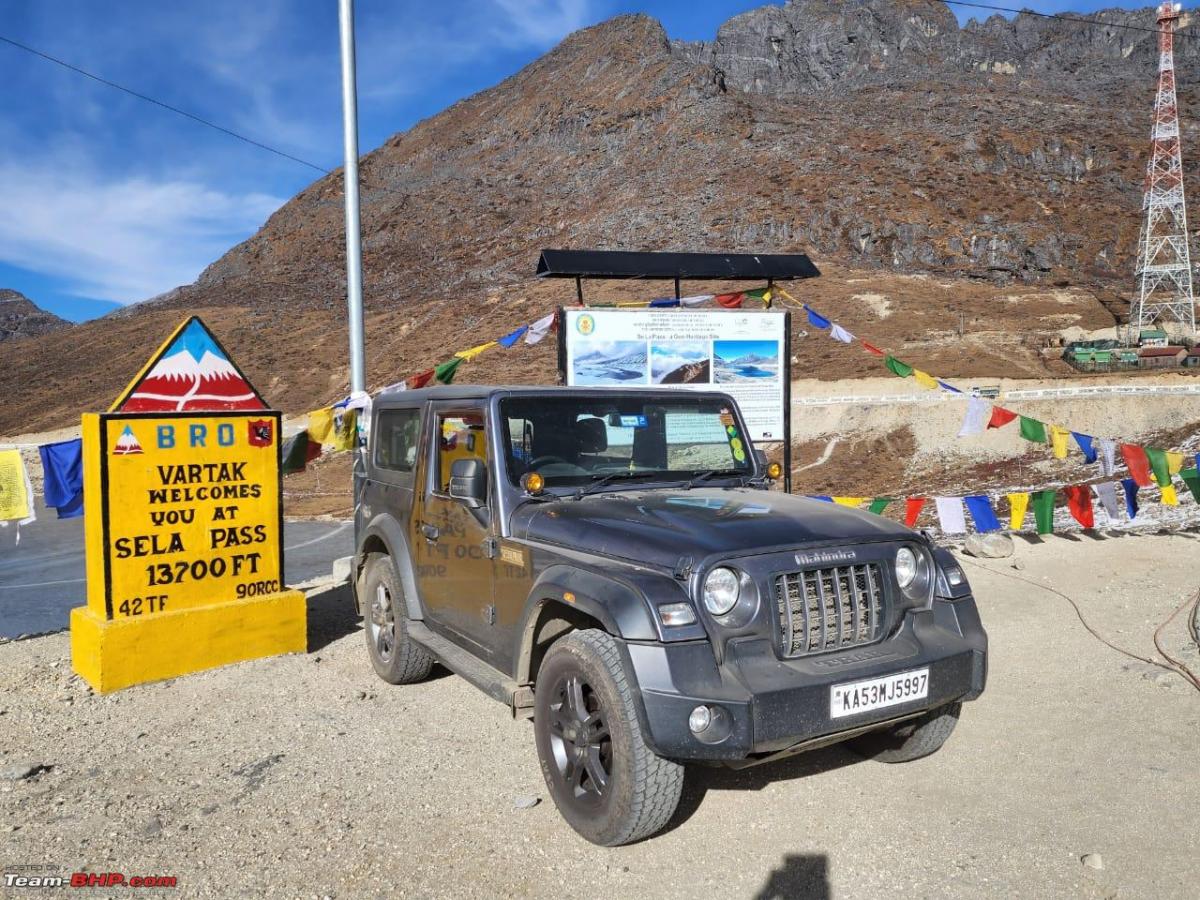
BHPian @Bibendum90949's Thar in Arunachal

Kaziranga National Park

Continue reading karthikd21's thread about the off-road expedition for BHPian comments, insights and more information.
News
Self-recovery tips & tricks when off-roading in a 4x4
My first approach is always slow, and if required, I increase the throttle. There is no shame in failing in the first attempt.
BHPian Samba recently shared this with other enthusiasts.
Many vehicle owners these days are taking their cars out for vacations to destinations that are beyond the beaten tracks. Thanks to the new good roads and highways and increased connectivity, this is now more and more possible and the preference for taking one's own vehicle is becoming more common for the sheer pleasure of driving.
However, beyond the regular Shimla, Manali, Darjeeling, Gangtok and Jaipur of the world, there are a lot of offbeat destinations where we want to drive down for the first time, but we are not sure as solo travellers, lest "something" should go wrong.
Ever wondered what that "something" could be? Is it the vehicle, or is it our fear of getting stuck in an unknown place in an inopportune situation?
This is not meant to be an offroading thread, it is rather a thread on how one can use one's knowledge of their own cars, and their own driving prowess for navigating through offbeat destinations.
So is it a 4x4 vehicle that gets you through?
Now in an affordable range, there are many 4x4 vehicles available, which can ferry a small family comfortably. But there are terrains where a 4x2 will also go with equal ease.
There are also many expedition teams that take people for self-drive to off-beat places. If a person does not have much prior experience with off-road trails, these guided expedition teams are a good way to experience the not-so-regular terrains.
Few people have adventure-ready vehicles equipped with things like off-road tyres, high lift jacks, winches, sand ladders, shovels, snorkel and many more. And they mostly know when to use these appropriately.
There are people who want to venture solo, or many people venture with their 2WD cars.
But that fear of "something" may be a situation where one is stuck in an isolated area, where there is no network on the phone to call for help.
On the other hand, when a not-so-equipped driver visits a place in a stock car, they may not be that prepared to take on a tricky situation. Plus carrying too many extra gears for the car will not leave enough space to pack your own luggage!
Is a 4x4 or SUV mandatory to take on bad roads? Not always! Even sedans and hatchbacks can negotiate bad roads if driven in the right way.
It is important to understand the limitations of your vehicle before venturing.
So let us have a small discussion in regards to travelling on the roads less travelled! Again a simple normal tar road can get tricky if it snows, rains or after a landslide!
Now OTRs and off-road clubs are getting popular day by day.
I believe that in most cases the cars are more capable than their drivers, primarily because we do not spend time to know our cars and stretch them to their threshold. It is important to stretch one's driving capabilities and one's vehicle in a measured way in a more controlled environment so that both our driving skills and our knowledge of our vehicles come in handy in real-life situations.
My suggestion will be, if you are into solo touring, and even if you do not own a 4x4, still sign up for OTRs to gain experience.
Drive a car in the OTR, and if it gets stuck, there is ample instant help available.
Knowing this will give you the comfort of also making an attempt of trying to recover the vehicle by yourself - which is extremely important.
There are loads of self-recovery tactics, and those videos are hugely available on YouTube. I will share a few links in this thread. One can learn from them and practice.
The below pics of my Duster and Etios are from OTRs, just to see the limitations of the vehicles & their drivers. Now I know how much water the Duster can handle or how much slush the Etios can handle!
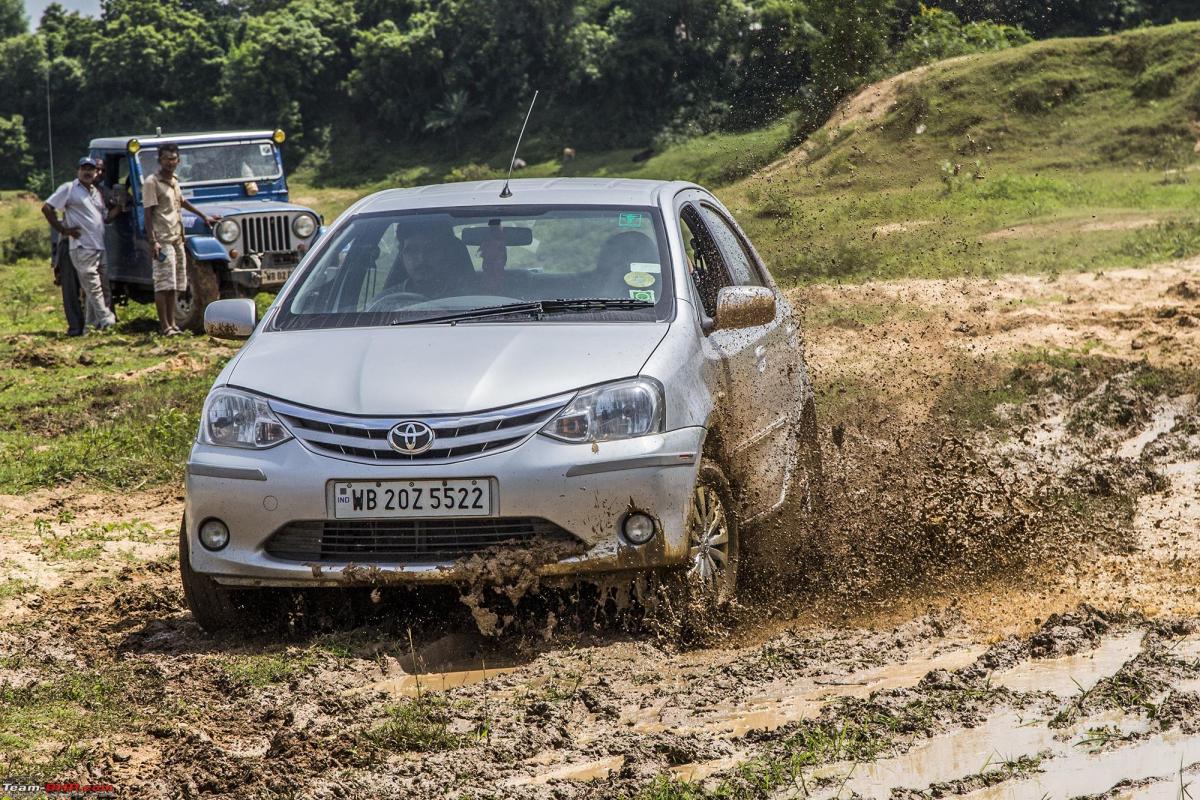

Continue reading BHPian Samba's off-road self-recovery for more insights and information.
- Tags:
- Indian
- 4x4 & Off-Roading
News
An Endeavour owner takes his Jimny to Leh: Overall driving experience
I just re-read what I wrote and realized that I haven't really anything bad to say about the Jimny.
BHPian SUVolens recently shared this with other enthusiasts.
A critical look at the Jimny driving experience
Day 4 was a designated break-day at Leh. A few of the travelers were first-timers to Ladakh and deserved a sight-seeing around Leh, one of us had to break away from the trip and return for a personal engagement and most importantly, the three back-to-back drives deserved a breather in between, before we headed into rarified air.
I feel, this would be a good opportunity for me to get into a more critical description of the Jimny, having covered approximately 900 kms over flat lands and hills. Truth be told, the sections after Leh were so involving, a totally objective review may not be possible, so let me do it while the others discover Leh.
Let's start with luggage capacity:
I have never really wanted to fix a roof-top carrier as a personal preference, so whatever luggage we had for three, had to go into the boot. Our last major overland was done in our (now sold) Endeavour, and with the third row folded flat luggage capacity was nothing short of a rugby flied. We are light packers anyway and luggage for three was restricted to two backpacks (40+20 litres), a shoe bag, a carton of emergency kit and the 20L jerry can.
When I swung open the boot door with all of these gathered on the floor, the task looked daunting. But as you can note from the photo in the first post, they all went in peachy and then sat snug under the cargo net stretched between the wall hooks. The luggage never rose above the rear sightline, so I'm guessing that a fourth person and his luggage would also have gone in at a push. So, luggage capacity is adequate if you are a frugal traveler.
From the driving seat
There have been more than enough written on this, but this is a purely personal angle. I'm tall and not very heavily built (not skinny either). I prefer my seat close to the steering for an elbows-bent position and my palms are almost always at 10-to-2 on the wheel. I find this allows me all-day driving capability without any major discomfort.
The Jimny has a few design problems for the above setup. First, no wheel reach adjustment - this means at my preferred position, my legs will get splayed out on either side. The right knee doesn't complain, but the left one taps into the center console. This isn't as bad as some cars can get, and after a while, I could ignore it easily. The seats themselves (front) aren't the widest, either for the back or for the bottom. But the fabric and the cushioning must be really well-engineered. All-day driving didn't produce any fatigue, there were no periodic calls from the body to get out and stretch and since the car doesn't exactly produce massive G-force around corners, bolstering works just fine. The abnormally tall headrest isn't the best for shorter passengers and they may request a neck-bolstering pillow.
The ICE and it's lack of physical controls is the next bugbear. At the very least, a nice round volume dial would've been an improvement over the touch-screen or steering toggle, which aren't the most intuitive or responsive. But while on the steering, I'd have to say that the control stalks on either side are a masterclass in simplicity and function. I put a lot of importance in how cars are designed for ergonomics, and it is clear how far apart a Suzuki stands from a lot of our homegrown brands and many foreign ones as well. They are so easy to activate even with your ring finger or pinky, without an mm of movement of your palms on the wheel. Extremely well damped, so lane-change indications are never a hit/miss. The large, accessible hazard warning button, the superbly sized and damped A/C controls (manual in the Zeta, mind it), everything shouts an attention to detail that belies the initial impression. It's suddenly apparent that the large touchscreen ICE was a much later addition and hence it falls afoul of the general ergos.
Appreciating the Jimny on open highways, is an acquired art. I got that much from my initial days. Now, a good 2k kms into the car, the engine and gearbox seems to be working out their kinks as we speed northbound at 100 kmph. The shift is no longer as notchy as when new. It isn't buttery..more like baked cheesecake. The engine runs at 3000 RPM or a smidge below and isn't loud at all. You don't even need the music or a loud conversation to try and mask it. And the ride is sheer comfort, both back and front, until you inattentively hit an unruly patch and the rear might step out just a bit. I guess here's where the damped steering and the slow old world system come into play. The car is easy to bring back into line and never does the wheel wrench at your hands.
When the climbs began after Udhampur, a few newer facets emerged. I have no direct recent comparison other than the Endeavour on these roads, so I'll use that as a template. The contrast couldn't be more stark - barge-like extremities to the little tugboat here. Twice the power output and more than thrice the torque from a turbo diesel to boot. 6 speed Auto, 5-link rear suspension, IFS, full-time 4WD...you get the picture. The Endeavour would ferry all on-board in complete bliss. If you wanted to, you could simply tilt back and sleep through the entire journey (and I've had my fellow-travelers subject me to that irritation before). Not so the Jimny.
This one wants you and your passengers in the 'here and now'. It's like being at a football match and not the opera. You can't just tip the shift into one cog or the other and think it'll chug its way up like a powerful diesel. And you'll not rest easy behind a smoky truck because you know there simply isn't enough room or opportunity to pass it till it allows you to. No Sir. From inside the narrow Suzuki, you're always scanning the gaps and the road 50m ahead. There's always a gap and there's always a cog to take it. Intent is the name of the game!
You know what - I just re-read what I wrote and realized that I haven't really anything bad to say about the Jimny. Sorry. It's just that I hadn't had anything to criticise up till Leh. But it wasn't all hunky-dory all the way. Things were about to change..
Read BHPian comments for more insights and information.
News
Taking my Mahindra Scorpio-N 4x4 to the Learn Offroad Academy
The convoy consisted of 2 Thars, 2 Endeavors, 1 Compass S, a modded Hilux and 2 Jimnys.
BHPian Mustang Sammy recently shared this with other enthusiasts.
Having driven Vader (my 4WD ScorpioN) for 11,000 km purely on-road (and I use the term liberally since those “roads” are in Mumbai and Pune) the urge to take him on rougher terrain was growing stronger. After a couple of missed windows, I finally managed to sign up for the Learn Offroad (LO) training academy run by D-BHP’ian Dr. Tejas Kothari (Tejas@perioimpl) for October 1, appropriately inflicting violence on myself and my steed before Gandhi Jayanti. The Doc was kind enough to share a primer on off-roading and the working principles of differentials, which proved quite handy during the course.
The below write-up is nowhere as thorough or illustrative as this one by BHPian Turbolove in his Compass, and this one by D-BHPian Axe77 in his Meridian is also very good. Still, storage is cheap, and TBHP is doing well, so I will take my chances with the moderators and share my $0.02
After gassing Vader up and emptying out the junk that invariably piles up in any vehicle I own, we were ready.
October 1 dawned bright and clear in Pune. We rumbled off at 6:30 a.m. to ensure enough buffer, as the expressway drive can be notoriously unpredictable. Luckily there were no surprises en route, allowing an idli wada and black coffee pit stop at Khalapur. Then we exited the highway and headed out on NH548A towards Pali, getting to the destination well within time, with some government-arranged off-roading patches along the way. A brand new lime green Jimny had beaten us to the post though. Our intrepid instructor and more students followed shortly after. A good mix of solo drivers, families and buddies.
Once all had assembled and imbibed hot chai nicely arranged by the Doc, we settled into the theory lesson, which was a refresher of the training with some more pointers. We were all handed walkie-talkies for comms, and then it was time to head into the field. The convoy consisted of 2 Thars (current gen), 2 Endeavors (3.2L), a Compass S, a modded Hilux, yours truly and 2 Jimnys (one of which was driven by Tejas). A short while into the drive we were instructed to put our vehicles into 4L mode, the first time ever for this bad boy.
After a short drive, we reached the first training area, where everyone reduced their tire pressures to 2/3 of rated levels.
The first course consisted of a steep descent into a muddy ditch followed by an equally steep climb up. The descent was to be performed in 1st gear using Hill Descent Control (if available) without using brakes. Everyone did it fine except for the writer, who forgot to put Vader into 1st (insert eye roll here) as a result of which he made a big splash when he entered the water. The exit from the ditch went off well, including the part where we had to simulate a failed ascent by stopping and restarting the climb. Vader was quite steamed about the episode afterwards, literally so, as the water that entered the engine compartment started evaporating due to the heat.
The next obstacle involved navigating around and over rocks on the trail, where we were guided by our fellow students. I proved not very good at following or giving instructions, which has been a consistent theme from schooldays till date. Going over rocks was quite educational, and we learnt the importance of the correct approach angle and getting the right momentum to be able to climb without the tire or the rock slipping and the tire/wheel getting damaged.
This was followed by an angled approach over a crest, where the right rear wheel was in the air for a short period, the first time in his history without being on a ramp. Then a crawl over very large pipes, which could have been taken a lot slower, but hopefully no harm done.
The next obstacle consisted of going down a muddy track and then climbing up a steep ramp, turning left using an external indicator (a tree branch in this case) just before a protrusion on the side of the mound that would hit the vehicle otherwise.
Then we broke for lunch and shot the breeze for a bit, before taking on the last 2 assignments.
The next one was possibly the highlight of the day, involving (what else) a descent down a slope, and then a climb up a rocky incline. There were 5 possible options to do the ascent, and Vader rode up like a champ. A couple of the participants tried more challenging routes, and hats off to their daring.
The last obstacle of the day (after a short dirt trail drive) was the off-camber challenge where you drive along the slope of the ditch and make a hard right turn at the end to get out. Due to the recent rains, the trail had become extremely slushy, and after a couple of aborted attempts by other participants (The Thars & Jimny excepted) yours truly chose discretion over valour and just drove in and out (the latter in reverse). Per Tejas, the ScorpioN overhang doesn’t lend itself well to such manoeuvres, which was of some comfort.
The day ended with a quick distribution of our certificates and a pose with our steeds.

Dark clouds had started looming, so the post-session chit-chat and vote of thanks was cancelled just in time for us to dive into our vehicles and make the return journey in pouring rain, stopping for some cows in between and then Gau-ing again till we hit the road, following which it was back to 2WD.
We then made our way to the gas station a few miles away, where we aired up the tires and headed home.
Vader held up quite well through the entire experience, only emitting a clanking noise in between when suspension must’ve hit, and another one that remained undiagnosed. He got a nice hose down a day later, and some well-earned rest. The ScorpioN and other 4WD vehicles of this generation are truly amazing, and make off-roading so much easier than before.
Thanks to the Doc for a great introduction to off-roading, and to my fellow students for the great company. This is just the beginning of more adventures, with family in tow from next time.
Check out BHPian comments for more insights and information.
- Tags:
- Indian
- 4x4 & Off-Roading
- SUVs
News
Rugged 4x4 for rural use: Maruti Jimny vs Mahindra Thar vs Force Gurkha
While Thar seems like it should be a reasonable choice, the lack of 4 doors and lack of storage space was a turn-off.
BHPian Grandizer recently shared this with other enthusiasts.
At present I have a Mitsubishi Outlander from 2010. I love my car. It has done over 194000kms, and even as recent as last year I have driven it from Dehradun, to Coonoor, and back! Crossing many places in India worth visiting! I love my car. It is fantastic!
But the rural parts I am looking to move to do not seem to have proper roads. People often tell me only 4x4s can go there, as often it is just a mud path on hilly terrain. I do not plan on 4x4ing just for the sake of it - it will be a necessity. Hence I am considering a new car.
Hence my requirements are:
- Should be 4x4
- Sufficient ground clearance
- Access to service center in rural area, without having to send it to a major metropolitan city.
- May drive to a city every once in a while from rural areas. Maybe 4+ hours each way.
- reasonable storage space for carrying some household supplies etc and possibly suitcases etc on weekend trips.
With those things in mind I seemed to move in the direction of:
- Mahindra Thar
- Suzuki Jimny
- Possibly a used army vehicle (temporarily since it may be cheap)
I decided to avoid a diesel purchase because of Gadkari's recent warning to car manufacturers to reduce diesel car production.
While Thar seems like it should be a reasonable choice, the lack of 4 doors and lack of storage space was a turn-off, since not only may I have to tranport supplies in bulk to my future residence, but also because I take my dog everywhere and there should be sufficient space for him (a German Shepherd).
Jimny seems better because of the 4 doors, and slightly more storage space. As it is a new car to the market, not so sure how other users feel about their experience with the car yet.
As for a used army vehicle I need to do more research. I happened to read some old posts where people were discussing the process etc. But seems like a possible stop gap option.
I would stick with my outlander if I could, but because it will be a rural area with possibly no road, outlander may not be able to traverse so easily. Servicing may also be more difficult in rural areas. Otherwise I love my outlander and feel it is the perfect car for me otherwise.
So was wondering what your thoughts are, and if you can chime in on more things to keep in mind when trying to make my selection. Or if there are any other existing vehicles or upcoming vehicles you think I should consider? Open to any guidance you feel will be useful. Thank you!
Here's what GTO had to say on the matter:
You're lucky because the choices are plentiful today!
Eliminate the Force Gurkha then. Also check which workshop is closer, Maruti or Mahindra?
Avoid army vehicles. They require way too much work & upkeep. Plus, they are slow and unreliable, even after rebuilds. I own a '97 Classic, so have been through the process.
- 4-door Thar coming in 2024, but will be more expensive than the already expensive 2-door Thar. You should wait for it.
- If you are looking at VFM, get the Jimny today. A+ mountain goat!
- If you are open to spending more, also consider the Scorpio-N 4x4.
Give the terrain a try in your Outlander first. Then decide whether you want to splurge on a new car. Although, IMHO, a 14-year old car with 200,000 km means it's time for an upgrade.
Here's what BHPian shankar.balan had to say on the matter:
If this is going to primarily be a passenger transport vehicle, your choices are spot on - the Thar or Jimny make great sense. Considering your description I would go for the Jimny because it is much more comfortable in terms of ride and has 5 doors. Very very useable because it is narrow and easy to get around our Indian conditions because most rural roads are narrow and a tight squeeze especially if a tractor or combine harvester is on the same road and you need to pass it.
If you add the EVCX Throttle Controller you will also be happy with the pep that the Jimny provides. I think both Maruti and Mahindra have more than enough service centres across India.
If at all you need a beater 4x4 vehicle for moving produce and other utility things, then an used Bolero pikup or old Thar or Gypsy may help.
Avoid ex Army and other similar vehicles unless you’re doing a passion based restoration project.
Here's what BHPian anjan_c2007 had to say on the matter:
Since an used Army jeep is on your list other than the MM550DP, please also add the Mahindra MM540DP/Classic and the CJ500D /Major to your list. These are extremely suitable for our Indian conditions and are extremely rugged too. And as regards the looming fear of diesel ban, a second hand Mahindra could set you back by Rs 2-3 L which is not rattling our personal finances. There are good chances that you may come across these in the used market. And more about the logic of such a "proposed" ban is discussed in the next para.
As regards Gadkari and his nausea for diesel, that's impossible and may remain a pipedream for him for the rest of his life. Because, the countless buses, trucks, mini-trucks ( 407, Aces, Dosts, Maximmos, Jeetos and more) and also defence vehicles cannot simply be banned overnight due to such whims and level headed political considerations must take precedence in a democracy.
Here's what BHPian aviator1101 had to say on the matter:
Since you don't want to buy a diesel vehicle, Scorpio N 4x4 is out of the list.
Avoid buying a Army auction Gypsy you will only end up wasting time and money. (Seen lot of such cases) As a hobby/restoration project, it's ok. But not as a utilitarian vehicle any more. Always remember, they have lives their life in the army, that's why they are with you.
The other petrol options as the other members already brought out is limited to Jimny and Thar. So not much to think about.
But if you re-consider of revoking your self imposed ban on purchase of diesels, do consider a used Bolero 4x4. It is damn tough and truly a go anywhere vehicle.
Read BHPian comments for more insights and information.
News
SOS Gear: BIS-approved Off-roading essentials for your next excursion
All products have been tested by BIS and NABL-approved labs in India.
SOSGear offers a range of products designed specifically for off-road use. These mainly include off-roading essentials and recovery equipment, which has been tested and certified in India.
SOSGear was founded by Dr. Tejas Kothari, an I4WDTA-approved trainer and founder of Offroad Junkie and Learn Offroad. The company has developed products like tow straps, shackles, and tyre pressure gauges in consultation with experienced off-roaders. Each product has been tested by BIS and NABL-approved labs in India.
Non Kinetic Static Tow Straps
Tow straps are available in two sizes: 3 m and 10 m, priced at Rs 2,750 and Rs 4,500, respectively. These are made from polyester and have a working load of 5 tonnes and a minimum breaking strength (MBS) of 13 tonnes.
Soft Shackles
Shackles are an essential part of a recovery operation. The benefit of soft shackles is that they float on water, unlike metal shackles. These are priced at Rs 3,500 and have a working load of 5 tonnes and MBS of 12.6 tonnes.
Metal Bow Shackles
The 3/4 inch screw pin type bow shackles are made from Grade 80 steel alloy and weigh 1.2 kg. They have a Working Load (WLL) of 4.75 tonnes. The Minimum Ultimate Load is 5 times the WLL. These are priced at Rs 499.
Analogue Tyre Pressure Gauge
The analogue gauge does not require batteries and comes with a pen-type clip to carry securely in the pocket. The gauge can display air pressure from 10-50 PSI, with a 1 PSI interval. It is priced at Rs 300.
Apart from offroad recovery equipment, SOSGear also offers products like Utility Gloves, Glove clips, kit bags and a Drawstring bag to store your tow straps.
Enthusiasts who wish to purchase the complete kit can opt for the Premium Recovery Kit option, which costs Rs 16,250. It includes a 3-meter and 10-meter tow strap, a pair of metal bow shackles, a pair of soft shackles, gloves, a glove clip, a tyre pressure gauge, an Offroad Recovery Kit bag, a pair of drawstring bags and a sticker set.
You can order SOS Gear's off-roading kit on their official website.
Pages



